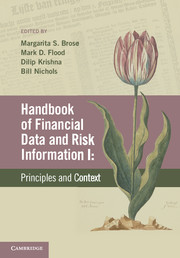Book contents
- Frontmatter
- Contents
- List of contributors
- Preface
- VOLUME I: PRINCIPLES AND CONTEXT
- PART I RISK MANAGEMENT CONTEXT FOR FINANCIAL DATA
- 1 A brief history of financial risk and information
- 2 Risk management
- 3 Portfolio risk monitoring
- 4 Frameworks for systemic risk monitoring
- 5 Data-driven regulation and financial reform: one perspective from industry on the financial crisis
- PART II REQUIREMENTS AND SOURCES FOR FINANCIAL RISK MANAGEMENT
- PART III REGULATORY DATA
- Index – Volume I
- References
4 - Frameworks for systemic risk monitoring
from PART I - RISK MANAGEMENT CONTEXT FOR FINANCIAL DATA
- Frontmatter
- Contents
- List of contributors
- Preface
- VOLUME I: PRINCIPLES AND CONTEXT
- PART I RISK MANAGEMENT CONTEXT FOR FINANCIAL DATA
- 1 A brief history of financial risk and information
- 2 Risk management
- 3 Portfolio risk monitoring
- 4 Frameworks for systemic risk monitoring
- 5 Data-driven regulation and financial reform: one perspective from industry on the financial crisis
- PART II REQUIREMENTS AND SOURCES FOR FINANCIAL RISK MANAGEMENT
- PART III REGULATORY DATA
- Index – Volume I
- References
Summary
Introduction
This chapter reviews where the debate on systemic risk frameworks now stands. The unprecedented costs and the complexity of the 2008 financial crisis have spurred academics and policy experts to look afresh at systemic risk and a number of different approaches have emerged with different practical implications for policy-makers. After some discussion of the background to this rapid rise in intellectual interest on systemic risks, this chapter groups different analytical approaches into three broad categories and then examines the data and policy implications of each category.
The 2008 crisis as a spur to systemic analysis
The cost of the 2008 crisis was enormous. For example, in the USA, the incremental loss above what one might think of as a normal downturn was about 3% of GDP, according to Phil Swagel of Georgetown University (Swagel, 2010). Andy Haldane, Bank of England Executive Director for Financial Stability, put the total first year loss of world output in 2009 at 6.5% of global GDP. If only 25% of that loss proved to be permanent, the net present value of the total loss would be close to one entire year's worth of global GDP (Haldane, 2010).
Economists from across the theoretical and political spectra have offered up various explanations of the crisis and generated conflicting proposals for how to prevent another one in the future. No dominant consensus has yet emerged on what was the fundamental cause.
At the time of writing, the global crisis is not over.
- Type
- Chapter
- Information
- Handbook of Financial Data and Risk Information IPrinciples and Context, pp. 105 - 147Publisher: Cambridge University PressPrint publication year: 2014
References
- 3
- Cited by



